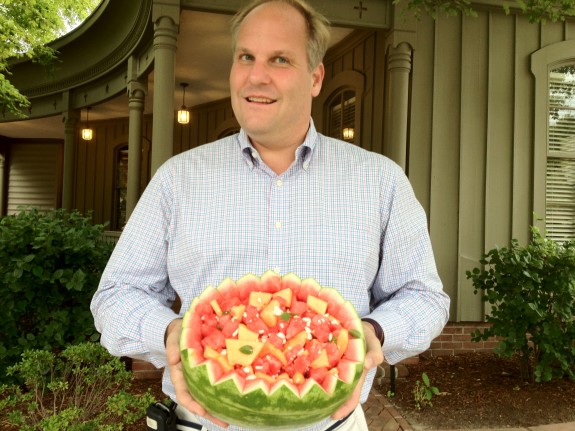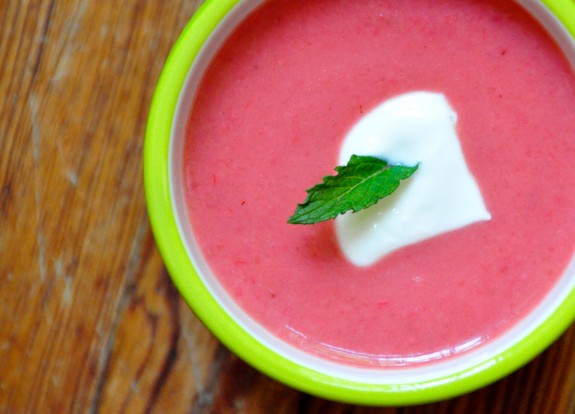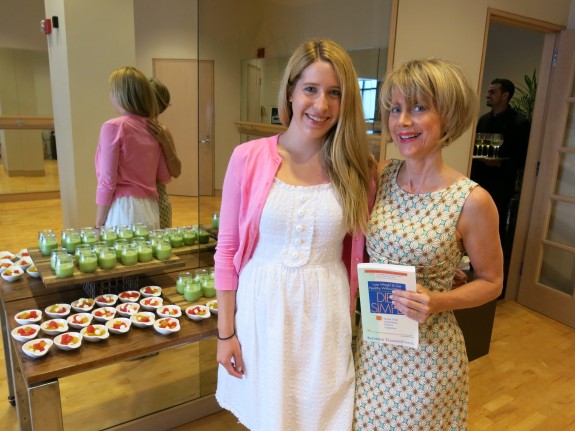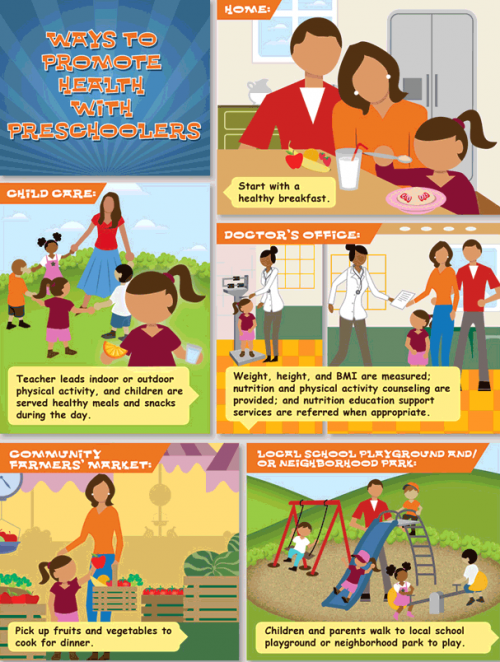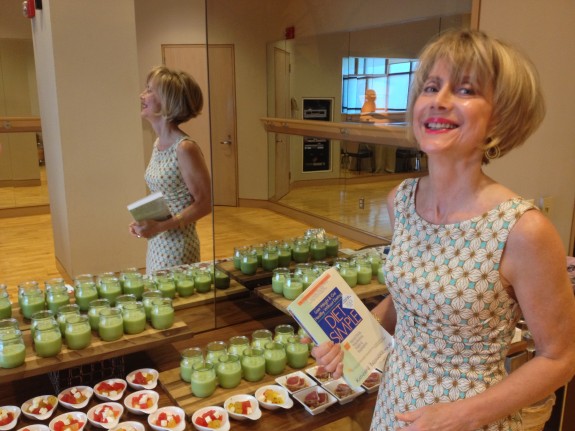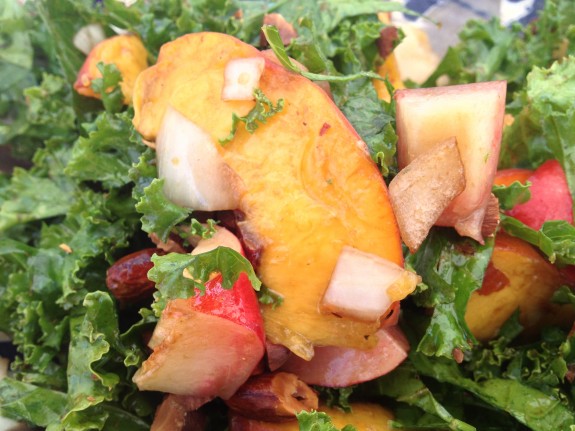Katherine’s Summertime Peach Crisp with Roasted Nuts, Dried Fruit & Ginger
- At August 10, 2017
- By Katherine
- In News, Recipes
 0
0

Katherine’s Summertime Peach Crisp with Roasted Nuts, Dried Fruit & Ginger (Photo by Alison Eaves, Washingtonian Magazine)
Katherine’s Summer Peach Crisp with Roasted Nuts, Dried Fruit & Ginger
By Katherine Tallmadge, M.A., R.D.
excerpted from “Diet Simple Farm to Table Recipes: 50 New Reasons to Cook in Season!” ($4.95)
Serves 12
Filling:
½ Cup Pure Maple Syrup
½ Cup Raisins, Dried Cranberries, or a mix of both
2 Tablespoons Fresh Squeezed Lemon Juice
1 teaspoon Minced Candied or Crystalized Ginger, to taste
2 Tablespoons All-Purpose Flour
3 pounds Seasonal, Ripe Peaches, peeled and thinly sliced
Topping:
1-1/2 Cups Old Fashioned Rolled Oats
½ Cup Chopped Walnuts, Pecans, Hazelnuts, any favorite Nut – or a mixture**
½ Cup Brown Sugar
1/3 Cup Whole Wheat Flour*
½ teaspoon Ground Cinnamon
1/3 Cup Walnut Oil, any Nut Oil,** or Canola Oil
Preheat oven to 350 degrees F.
Prepare filling: In a large bowl, mix the maple syrup, dried fruit, lemon juice, ginger, and flour. Add the peaches and mix well. Pour into a 9-by-13-inch baking dish.
Prepare Topping: Mix the oats, nuts, brown sugar, whole wheat flour, and cinnamon. Add the oil and mix until the topping is moist. Pour over the filling in the baking dish.
Bake for 45 to 50 minutes or until the apples are tender and the crumble is golden brown. Let stand for 10 minutes until serving
300 calories per serving.
“Katherine’s Summer Peach Crisp with Nuts, Dried Fruits, and Ginger” is adapted from a recipe in “Eating Well” Magazine.
*A whole grain – whole oats and whole wheat flour – has three parts: bran, germ and endosperm. The bran and germ contain fiber, Vitamin E, B vitamins (thiamin, niacin, riboflavin and pantothenic acid) minerals (calcium, magnesium, potassium, phosphorous, sodium, selenium and iron), protein, essential oils, antioxidants and phytochemicals (plant substances that may protect health). The endosperm contains mostly starch with a little protein and very few nutrients. When a grain is refined, turning whole wheat flour into white flour or brown rice into white rice, only the nutrient-poor endosperm is left. The heart-healthy, cancer-fighting riches found in the bran and germ are lost. Learn more about whole grains…
**Nuts – Every time a new study comes out about nuts – any nut – it’s positive news. Nut eaters around the world have fewer heart attacks, and we know that most of the protective nutrients are in the oil of the nut. While you already know each nut has a different look and flavor, each nut also has its own unique nutritional characteristics. For instance, almonds are the highest in protein and Vitamin E, and the lowest in artery-clogging saturated fat. Walnuts are the only nut with omega-3-fatty acids. Pecans have the highest antioxidant content. Pistachios contain lutein, a compound which may significantly improve eye health. ALL nuts are good for you. My favorite: Italian Hazelnuts!
Sweet Summertime Melon Chunks with Crumbled Feta and Fresh Mint
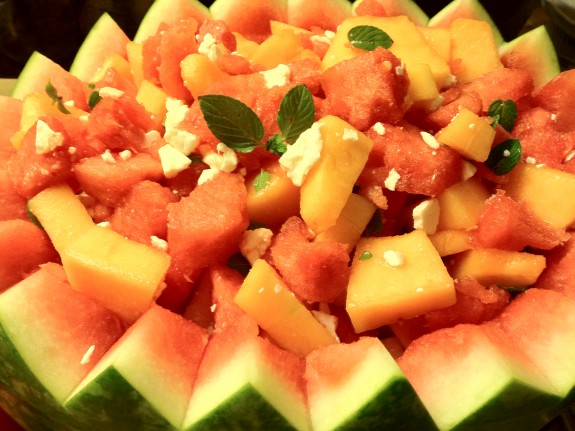
Sweet Summertime Melon Chunks with Crumbled Feta and Fresh Mint (from “Diet Simple Farm to Table Recipes”)
Excerpted from “Diet Simple Farm to Table Recipes: 50 New Reasons to Cook in Season!“
It’s melon season and a vast number of varieties are now available, and will be for quite a while. These days melons come in an amazing array of colors, shapes, textures, and flavors. Use a combination of any melons for this very simple, yet elegant recipe. This is an unusual combination of flavors and textures, and a delight on the palate. Use any kind of melon that happens to be in season.
Serves 8
2 pounds melon chunks (about 1 small cantaloupe or seedless watermelon)
½ pound Feta Cheese or other similar cheese
8 small mint leaves, Chiffonade (Basil will also work)
Combine ingredients in a large bowl and serve!
My Favorite Asparagus Recipes
Spring has always seemed more like the new year to me than January first. Perhaps my inspiration comes from longer, warmer, sunlit days, delicate vegetables and fruits, like asparagus and strawberries, finally popping up, flowers blooming everywhere. Neighbors begin venturing out of winter hibernation with their first happy greetings of the year, with sounds of their children playing in the street. Celebrations are occurring all over the city showing off our beauty and splendor to the tourists. In fact, I think I’ll make my New Year’s Resolution today! And it’ll be easy – preparing batches of veggie salads – or soups, at least weekly, to help me and my friends shed some of our winter “padding.” Making delicious veggies your main course at dinners (lunches, too) helps manage your weight easily. Asparagus is one of my major harbingers of spring. Here I’d like to share some of my favorite asparagus recipes excerpted from my book, Diet Simple Farm to Table Recipes: 50 New Reasons to Cook In Season!, where you’ll find dozens of other seasonal recipes:
Chilled Asparagus in a Creamy Tarragon, Shallot and Roasted Walnut Vinaigrette
Salad of New Potatoes and Asparagus with Lemony Garlic Herb Mayonnaise
Pasta with Pesto, Roasted Asparagus and Cherry Tomatoes
Asparagus Salad in a Vietnamese-Style Dressing
Preventing Prostate Cancer Through Diet and Lifestyle
- At October 03, 2013
- By Katherine
- In Articles, News
 1
1
Nutrition makes a difference!
by Viggy Parr with contributions by Katherine Tallmadge
When men move to the United States or adopt a more westernized diet, their prostate cancer rates increase dramatically.
Based on international comparisons of prostate cancer rates in different countries and over time, studies where researchers examine the lifestyle and health of a group in one location and compare that to the lifestyle and health of a group in a different location—have shown that Asian men, who have some of the lowest worldwide rates of prostate cancer, increase their risk of that cancer when they adopt a Western (American) diet with more animal foods. A recent study (Ahmedin et al, 2010) found that rates of prostate cancer are rising in countries with formerly low rates, such as Japan and Singapore because of westernization, including a sedentary lifestyle, diets filled with animal fats, and rising rates of obesity. These results prove that there is not necessarily a genetic protection against prostate cancer in Asian men, but rather a strong environmental factor.
I hope that the following lifestyle advice can benefit all men and help them to significantly reduce their risk of prostate cancer and help them to live a long and healthy life! (1) Learn more about PSA testing controversies..
1. Body fat: The American Institute for Cancer Research recommends at least 30 minutes of physical activity each day to reduce body fat and help prevent cancer in general. This recommendation is particularly important for prostate cancer.
“Although most men will develop prostate cancer if they live long enough, the cancer often remains dormant and never impacts their health. Only a small minority of men will develop the aggressive form of prostate cancer that can be fatal,” ccording to Karen Collins, MS, RDN, a registered dietitian and nutrition advisor for the American Institute for Cancer Research (AICR).
Overweight men are more at risk for aggressive prostate cancer than men of normal weight. The reasons behind this are not entirely clear; Collins suggests that the hormone changes involved in weight gain or even obesity-caused chronic low-grade inflammation could be the culprit. Inflammation is associated with many cancers for reasons that are not fully understood. Collins explains that inflammation could set off changes in cell signaling pathways that could lead to changes in cell growth and reproduction and the cell’s ability to self-destruct, ultimately leading to cancer.
- Bottom line: You don’t have to spend hours at the gym to get the cancer-preventing health benefits of exercise—a simple walk through the neighborhood can do wonders for your health. Exercise can be fun, too—try an active game of golf or badminton with friends, yoga, kayaking, paddle boarding, volleyball, swimming—any activity that gets your heart pumping is perfect!
- Body fat: 8 Steps to Determine – Are YOU dangerously overweight? Learn more about PSA testing controversies!
2. Lycopene (Red fruits such as tomatoes, watermelon, guava): Many studies have shown that lycopene-rich foods reduce the risk of prostate cancer, but the mechanism behind that reduction was not well understood until now. A recent study found that lycopene has a substantial protective effect against prostate cancer by interfering with the genes that would allow the prostate cancer cells to grow and survive. The American Institute for Cancer Research recommends that men take advantage of lycopene’s cancer-preventing effects and fill their diets with foods such as tomatoes, watermelon and guava.
- Bottom line: Fill your diet with lycopene-rich foods such as tomatoes, watermelon, and red grapefruit. Remember—the cancer-fighting properties of lycopene in tomatoes are much stronger when the tomatoes are cooked, such as in marinara sauce or tomato soup.
- Source: Rafi, MM, S Kanakasabai, MD Reyes, and JJ Bright. “Lycopene modulates growth and survival associated genes in prostate cancer.” Journal of Nutritional Biochemistry 2013.
3. Selenium: The AICR recommends incorporating selenium-rich foods into your diet to help decrease your prostate cancer risk. Selenium is essential to proper immune system and thyroid functioning, and it has been shown to be anti-carcinogenic. In addition to its powerful preventive effects, selenium may also slow prostate tumor growth. One of the best sources of selenium is the Brazil nut. Besides being a great selenium reservoir, Brazil nuts are high in protein, fiber, magnesium, and phosphorus, along with vitamin E, vitamin B6, calcium, and iron, just to name a few. These nutrient powerhouses can also help lower cholesterol.
- When paired with vitamin E, selenium packs an extra punch in preventing prostate cancer. Almonds are a great source of vitamin E and have a host of other health benefits, as well.
- Bottom line: Enjoy selenium-rich foods such as brazil nuts, sunflower seeds, eggs, mushrooms, grains, and onions to help lower your risk of prostate cancer.
- Source: Yang, Jun. “Brazil nuts and associated health benefits: A review.” LWT-Food Science and Technology 42(10): 2009.
4. Cruciferous vegetables: Consumption of vegetables in the crucifer family, including broccoli, cauliflower, and cabbage has recently been linked to a decrease in prostate cancer risk. Chemicals in vegetables like broccoli can suppress the growth of prostate cancer cells and therefore prevent development of the disease.
- Source: Watson, GW, LM Beaver, DE Williams, RH Dashwood, and E Ho. “Phytochemicals from Cruciferous Vegetables, Epigenetics, and Prostate Cancer Prevention.” The American Association of Pharmaceutical Scientists Journal: 2013. http://www.ncbi.nlm.nih.gov/pubmed/23800833
- Bottom line: Even if delicious, nutritious foods like broccoli and cauliflower don’t definitively reduce your risk of prostate cancer, they are still incredibly healthful foods with a huge variety of proven benefits. Toss some broccoli into your salad or replace the mashed potatoes with some smashed cauliflower!
5. Vegetable fats: A long-term study of men with prostate cancer found that men who ate more vegetable fats (think nuts, avocados, and nut oils) had a significantly reduced risk of dying from any cause. Simply swapping ten percent of daily carbohydrates for vegetable fats lowered the men’s risk of death by 26 percent, and swapping vegetable fats for ten percent of daily animal fat reduced the men’s risk of death by a whopping 34 percent.
- Bottom line: Instead of cooking foods in trans-fatty oils or bacon fat, use olive or peanut oil. Foods such as nuts, avocados, peanut butter, and olives are good sources of vegetable fats, as well.
- Source: Richman, Erin L., Stacey A. Kenfield, Jorge E. Chavarro, Meir J. Stampfer, Edward L. Giovannucci, Walter C. Willett, and June M. Chan. “Fat Intake After Diagnosis and Risk of Lethal Prostate Cancer and All-Cause Mortality.” JAMA Internal Medicine 2013. http://www.ncbi.nlm.nih.gov/pubmed/23752662
6. Animal fats: Frequent meat-eaters beware: studies have shown that diets high in animal fats can increase your risk for prostate cancer. Studies of the often vegetarian Seventh-Day Adventists show decreased rates of prostate cancer in that population compared to the national average.
- Source: Le Marchand, Loic, Laurence N. Kolonel, Lynne R. Wilkens, Beth C. Myers, and Tomio Hirohata. “Animal Fat Consumption and Prostate Cancer: A Prospective Study in Hawaii.” Epidemiology 5(3): 1994. http://www.ncbi.nlm.nih.gov/pubmed/8038241
- Milk: A recent studyfound that whole milk, which is high in animal fat, is associated with more aggressive, fatal prostate cancer. Skim/low-fat milk was associated with less aggressive prostate cancers. Some researchers believe that the calcium in milk may be behind milk’s association with prostate cancer, while others believe that natural growth factors in milk are the true cause. Men are urged to be careful about calcium supplements—as with many types of foods, it’s necessary to find the middle ground between too much and too little calcium. Whereas excessive calcium (1200-1500+ mg/day) is associated with increased prostate cancer risk, adequate calcium consumption in general is pretty clearly associated with lower risk of colon cancer. According to Collins, “You’d hate for men to get the idea that they should totally minimize their calcium intake, since some calcium in moderate amounts doesn’t seem to increase prostate cancer risk.”
- Source: Song, Y, JE Chavarro, Y Cao, W Qiu, L Mucci, HD Sesso, MJ Stampfer, E Giovannucci, M Pollak, S Liu, and J Ma. “Whole milk intake is associated with prostate cancer-specific mortality among U.S. male physicians.” Journal of Nutrition 143(2): 2013. http://www.ncbi.nlm.nih.gov/pubmed/23256145
- Bottom line: It’s not a bad idea to reduce your meat intake. If you do eat meat, opt for leaner meats such as chicken and fish instead of fatty beef. It also wouldn’t hurt to cut back on milk or switch to skim milk.
7. Soy: Stanford researcher Dr. David Feldman has found that soy can have protective effects against prostate cancer. Genistein, a soy phytochemical, can boost calcium absorption by protecting a vitamin D-derived chemical, calcitriol, against breakdown. A study involving rats found that when placed on a high-soy diet and given supplements of calcitriol, the rats were much less likely to grow prostate tumors.
- Bottom line: This doesn’t mean that you should load up on soy and vitamin D—some of the mice in the soy-vitamin D study developed hypercalcemia, a condition that occurs when there is too much calcium in the blood. Enjoy minimally processed, nonfermented forms of soy every now and then, such as tofu and soy milk.
- Source: Studying D, Soy and Prostate Cancer. AICR Newsletter. http://www.aicr.org/publications/newsletter/2013-winter-120/studying-d-soy-and-prostate.html
- Source: http://www.huffingtonpost.com/craig-cooper/soy-and-chocolate-too-muc_b_756604.html
8. Fried foods: A new study from the University of Washington has found that regularly eating fried foods such as French fries and fried chicken could increase your prostate cancer risk. The high heats involved in deep-frying create new molecular compounds that may be carcinogenic. You don’t necessarily need to swear off doughnuts and fries forever—the study also found that men who ate fried foods one to three times a month did not have an increased risk for prostate cancer.
- Bottom line: Try to replace fried foods with fresh foods whenever possible, but if you simply have to have a doughnut or fries, limit yourself to one or two indulgences per month.
- Source: Stott-Miller, Marni, Marian L. Neuhouser, and Janet L. Stanford. “Consumption of deep-fried foods and risk of prostate cancer.” The Prostate 73(9): 2013. http://www.ncbi.nlm.nih.gov/pubmed/23335051
9. Omega–3 fatty acids: A recent study by Dr. Theodore Brasky and colleagues found that high blood levels of omega-3 fatty acids is associated with an increased risk of prostate cancer. However, the study suffers from several serious methodological flaws. The study did not examine any aspects of diet in the volunteers, nor did they ask if the men were taking fish oil supplements. All assessments of omega-3’s were performed by measuring omega-3 blood levels. Karen Collins of AICR cautions that the real issue is all about balance; the balance of omega-3’s and omega-6’s (another type of essential dietary fat) seems to be very important for inflammation. People who eat little to no fish and fill their diets with processed foods may have inadequate consumption of omega-3’s, whereas someone else could go too far in the other direction and throw off that delicate balance by eating a low fat diet with omega-3 supplements. There is likely a tipping point at which omega-3’s cease being helpful and start to be harmful due to the imbalance that too many omega-3’s can cause, much like calcium and milk. It’s important to recognize that although omega-3’s are important, the rest of the diet and lifestyle must also be taken into account. For example, the Inuits, the native people of Greenland, have a diet rich in fish, giving them plenty of omega-3’s. The Inuits also have incredibly low rates of prostate cancer.
- http://www.cnn.com/2013/07/12/health/salmon-cancer-time/index.html (Brasky research)
- Brasky, TM, AK Darke, X Song, CM Tangen, PJ Goodman, IM Thompson, FL Meyskens, Jr., GE Goodman, LM Minasian, HL Parnes, EA Klein, and AR Kristal. “Plasma Phospholipid Fatty Acids and Prostate Cancer Risk in the SELECT Trial.” Journal of the National Cancer Institute: 2013. http://jnci.oxfordjournals.org/content/early/2013/07/09/jnci.djt174.abstract
- Dewailly, E, G Mulvad, H Sloth Pedersen, JC Hansen, N Behrendt, and JP Hart Hansen. “Inuit are protected against prostate cancer.” Cancer Epidemiology, Biomarkers & Prevention: 12(9): 2003. http://www.ncbi.nlm.nih.gov/pubmed/14504206
Conclusion
By eating in accordance with the most up-to-date scientific evidence, you could help reduce your risk for prostate cancer. Start by filling your diet with lycopene-containing foods like tomatoes, watermelon, and grapefruit, selenium-rich foods like brazil nuts, eggs, and mushrooms, vegetable fats like nuts and avocados, and cruciferous vegetables like broccoli and cauliflower. What you add in is just as important as what you leave out—try to cut back on red meat, whole milk, and fried foods. Top everything off with at least 30 minutes of exercise each day and you’ll be doing both yourself and your family a whole lot of good. Collins points out that “for cancer overall, we are discovering so many protective compounds in food that we should focus on variety rather than a few superstars to eat over and over again.” Take her advice and mix it up once in a while. If you follow all of the tips in this article, you’ll be taking full advantage of the most up-to-date prostate cancer prevention science and improving your overall health along the way!
Sources:
Jemal, Ahmedin, Melissa M. Center, Carol DeSantis, and Elizabeth M. Ward. “Global Patterns of Cancer Incidence and Mortality Rates and Trends.” Cancer Epidemiology, Biomarkers & Prevention 2010. http://cebp.aacrjournals.org/content/19/8/1893.long
Learn more about PSA testing controversies!
Summer’s Last Sigh… Market Recipe: Greek Salad with Heirloom Tomatoes
- At September 27, 2013
- By Katherine
- In News, Recipes
 0
0

Four Seasons Displaying Greek Salad with Heirloom Tomatoes, Tabouleh with Chick Peas, Seasonal Vegetables and a Lemon, Basil Vinaigrette, and Fruit Smoothies, all from "Diet Simple Farm to Table Recipes" and prepared by Four Seasons Hotel Executive Chef Douglas Anderson for my Presentation: 4 Steps to Building Muscular Strength
Don’t say good-by to summer yet. There is still plenty of summer’s most lovely seasonal produce, particulary heirloom tomatoes – my favorite – to entertain with, as evidenced by Four Seasons’ beautifully prepared Greek Salad with Heirloom Tomatoes, and other recipes from Diet Simple Farm to Table Recipes. They were uniquely and beautifully interpreted by the Four Seasons Hotel Executive Chef Douglas Anderson for my presentation, “Four Steps For Strengthening Muscles – Some Surprising News” exclusively for Four Seasons Health Club members.
Every vegetable in the recipe – the tomatoes, cucumbers, peppers, sweet onions, and garlic – can be found at the local Farmers Markets at Rose Park on Wednesday or Dupont Circle on Sunday or any other Fresh Farm Market locations. The possibilities are endless! This is a naturally vegetarian recipe. But for the meat lovers, it’s great with grilled chicken or seafood on the side.
“Katherine’s Market Recipes,” are designed to be delicious, easy, quick, family-friendly, nutritious (heart-healthy & diabetes-friendly), and to highlight produce found at our local Farmers Markets this week. At your Farmers Market, you’ll find produce picked at peak ripeness, which means maximum flavor, texture and nutrition. You’re also helping save the environment when you buy at your Farmers Market. Here’s how…
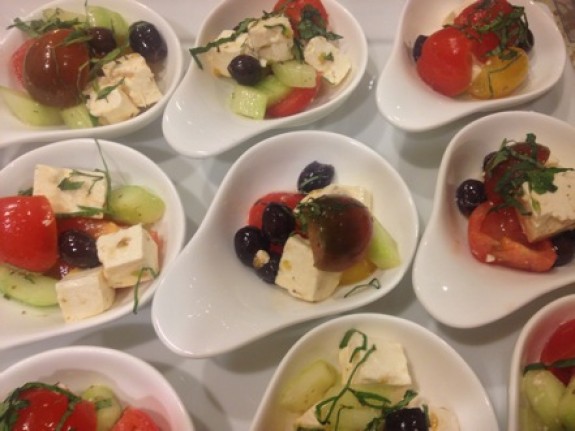
Greek Salad with Heirloom Tomatoes as interpreted by Four Seasons Hotel Executive Chef Douglas Anderson
Greek Salad with Heirloom Tomatoes
From Diet Simple Farm to Table Recipes: 50 New Reasons to Cook in Season!
8 servings
Ingredients:
Vinaigrette:
2 Tablespoons Freshly Harvested Extra Virgin Olive Oil
2 Tablespoons Freshly Squeezed Lemon Juice (1 Lemon)
1 Tablespoon Chopped Fresh Oregano or Basil (or 1 tsp dried)
1 Clove Garlic, Minced (optional)
Salt and Pepper to Taste (Salt is not necessary with the cheese and olives)
Vegetables:
2 cucumbers, peeled, seeded and sliced into a half-moon shape
1 onion, peeled and chopped coarsely
1 medium yellow, purple or green bell pepper, cored, seeded, chopped into large bite-size pieces
1 cup pitted Kalamata or other Greek Olives
4 Heirloom Tomatoes, quartered, and cut into large, bite-size pieces
4 ounces Feta or Goat Cheese, broken into small bits
Instructions:
Combine the vinaigrette ingredients in a large salad bowl and whisk until blended. Add the cucumbers, onion, pepper, and olives and toss into vinaigrette. Let sit for twenty minutes to marinate. Add the heirloom tomatoes and cheese when ready to serve.
Tomatoes are one of the “superfoods.” Men who consumed 10 or more servings of tomato products a week had a 35% decrease in risk of prostate cancer relative to those who consumed 1.5 servings or fewer per week. This is largely attributed to “lycopene” in the tomatoes, which is also in other red fruits such as watermelon, pink grapefruit and guava. Men with lycopene levels in the top 20% had a 46% decrease in risk of heart attack compared to those in the bottom 20%. Lycopene is a potent scavenger of gene-damaging free radicals. But don’t expect to get it from a supplement. You must eat the tomato as you need the whole food to receive the benefits! Here’s an explanation…
Lycopene (Red fruits such as tomatoes, watermelon, guava): Many studies have shown that lycopene-rich foods reduce the risk of prostate cancer, but the mechanism behind that reduction was not well understood until now. A recent study found that lycopene has a substantial protective effect against prostate cancer by interfering with the genes that would allow the prostate cancer cells to grow and survive. The American Institute for Cancer Research recommends that men take advantage of lycopene’s cancer-preventing effects and fill their diets with foods such as tomatoes, watermelon and guava.
- Bottom line: Fill your diet with lycopene-rich foods such as tomatoes, watermelon, and red grapefruit. Remember—the cancer-fighting properties of lycopene in tomatoes are much stronger when the tomatoes are cooked, such as in marinara sauce or tomato soup.
Obesity Rates Declining? Nothing Short of Miraculous!
- At August 10, 2013
- By Katherine
- In Articles, News
 0
0
I was asked by the newly launched Washington Post TV’s “On Background” to discuss last week’s news reports of the first decline in childhood obesity in decades. Childhood obesity decreased in 19 states, according to the latest Centers for Disease Control data. This modest decline is nothing short of miraculous because overall, America’s food and physical activity environment seems worse than ever. Calorie-dense snack foods and fast foods are everywhere – easily and cheaply available. Children and adults spend even more time sitting in front of computers, televisions, in classrooms and cars than just a few years ago. This reversal means families, parents, caretakers, teachers, and schools are making huge efforts to overcome these negative influences.
Reversing obesity in our culture, where overweight is the norm (2 out of 3 adults and 1 out of 3 children are overweight or obese), takes effort ; it’s not an accident! Adults are making better – harder – choices for children. Americans may be slowly internalizing the need for healthy eating and exercise. Just as smoking was once considered normal adult behavior, we’re gradually realizing that mindful meals and physical activity must be made a societal norm. And that’s great news… for children, for their families, and for our country, which spends billions of dollars annually on obesity and its related diseases, including type 2 diabetes, heart disease, cancer, and more.
“Obese children are more likely to become obese adults and suffer lifelong physical and mental health problems,” according to the CDC. “Obesity rates in low-income preschoolers, after decades of rising, began to level off from 2003 through 2008 and now are showing small declines. However, too many preschoolers are [still] obese,” continued the report.
Are you dangerously overweight? Find out by checking out my 8 Steps!
Some reasons given for the successful reversal of obesity:
It seems small, simple changes have been responsible for this amazing improvement in the health of children. The power of small changes is described in my Diet Simple chapter: “Easy Solutions for Your Kids,” with tons of ideas easily integrated into your family life. Just adding fruits and/or vegetables at each meal or 15 extra minutes of daily physical activity can make a huge difference in a child’s health and weight. For fun, easy recipes and tips, buy Diet Simple: 195 Mental Tricks, Substitutions, Habits & Inspirations, and for more recipes, buy Diet Simple Farm to Table Recipes.
Katherine Featured on CBS Evening News, 2010
Are you dangerously overweight? Find out by checking out my 8 Steps!
Six Slimming Strategies for Your Summer Vacation
- At July 30, 2013
- By Katherine
- In Articles, News
 0
0

Katherine Tallmadge Kayaking on the Miles River during a recent vacation with a hand-carved Greenland paddle by Bob Baugh
A new client came in feeling desperate: She gained 10 pounds on her summer vacation. I’ve heard this sad story before; but it doesn’t have to end this way! In fact, just the opposite…
Cruise Control
Two of my clients recently reported shock at losing weight on their Mediterranean cruise vacations. Lorraine, a 53-year-old public health specialist in Washington, D.C., came home from a cruise and was surprised to find she had lost two pounds. Rick, a professor of psychiatry and behavioral sciences in D.C., lost six pounds during his 10-day cruise.
Both remarked that they had indulged in ice cream, desserts, pasta, bread, and other foods that they didn’t usually eat. Yet, they dropped weight on vacation, despite struggling to lose pounds at home. As soon as they returned, the pounds began piling on, and they came to me desperate to return to the seemingly magical weight-loss mode they had fallen into during vacation.
I agreed that it was confusing. Both claimed they weren’t trying to diet and had eaten without restriction. Lorraine didn’t exercise any more than usual and had proof: Her pedometer, which measures her daily steps, showed the same readings she recorded at home. Rick may have walked more than usual—he didn’t wear his pedometer—but that alone doesn’t explain a six-pound loss, especially given his decadent eating.
Most of us are accustomed to accidentally gaining weight on cruises, not losing it. Tasty, fattening food is available all day long. During every meal, you’ll have a few hors d’oeuvres, then an entree, and who can resist dessert? Even midnight buffets. It’s not uncommon to gain even a pound a day while on a cruise or vacation.
So, how did these cruises turn into weight-loss adventures? And how can you replicate the conditions that worked for my clients—without getting seasick in the process?
As Lorraine and Rick described their experiences, some patterns quickly emerged:
- They ate whatever they wanted, from desserts to bread to pasta,
- They didn’t exercise, though they walked a lot during stops in ports (about 12,000 steps a day, according to their pedometers),
- Every meal featured buffets, stocked with a wide array of fruits and vegetables.
My analysis? The variety and volume of fresh, healthy food helped to properly nourish my clients.
Variety: The Most Significant Factor Influencing How Much You Eat!
Studies indicate that variety, more than any other factor, influences how much we eat. The more diverse food options we encounter, the more we eat without even realizing it. The desire for dietary variety is important for health and helped humans to evolve. People who ate lots of different types of food each day were—and still are—more likely to obtain all the essential nutrients. Based on this theory, a buffet would lead to a higher calorie intake and weight gain. But Rick and Lorraine’s cruise buffets had an unusually large and varied number of beautifully prepared fruits and vegetable dishes, from fresh chopped fruit to salads and cold vegetable soups. While exposure to a variety of fattening foods causes weight gain, access to a variety of fruits and veggies promotes weight loss. Though they didn’t consciously realize it at the time, both Rick and Lorraine ate more fruits and veggies before, during, and between meals.
Volume: Feeling Full While Eating Fewer Calories?
Some foods are less energy dense than others—that is, they have fewer calories per gram—so filling your plate with more of those means you’ll be eating fewer calories without actually eating less food. Low density foods, which are low in calories but high-volume, help you feel full and satisfied while dropping pounds. Fruits and veggies are ideal, since they’ll fill you up without breaking your calorie bank; they’re correlated with a lower body weight. Eating high-volume, low-calorie foods affects how satisfied we feel in a number of ways. It causes stomach stretching and slows stomach emptying, stimulating the nerves and hormones that signal feelings of fullness. There’s also a visual component—seeing a large volume of food increases our ability to feel satisfied by it. Studies also suggest that when we eat large meals that last a long time, our satisfaction declines and we lose interest in finishing them.
Why They Ate Whatever They Wanted – And Lost Weight
Still wondering how Rick and Lorraine ate whatever they wanted, including desserts, and managed to lose weight? My analysis is that the fruits and veggies were so plentiful and took up so much room in their stomachs, they both ate less of everything else. Plus, they felt that they had eaten to their hearts’ content.
You too can get on “cruise control” at home and enjoy eating the right number of calories, feeling satisfied and even losing weight without trying. Rick and Lorraine’s cruise experiences are perfect examples of how this can happen. To replicate their results, consider having a buffet of fruit and veggie dishes in your home and office—morning, noon, and night. Pre-prepare a large variety of these, so they’re easily accessible and grab-able. And since exercise counts too, put on a pedometer and aim for the recommended 10,000 steps a day. (About 2,000 steps is one mile. The average office worker gets about 4,000 steps daily.)
Dishes you may find on your Mediterranean Cruise (all found in Diet Simple Farm to Table Recipes):
Melon Chunks with Crumbled Feta and Fresh Mint
Nora’s Watermelon Gazpacho
Fresh Summer Salsa with Watermelon
Six Strategies
(excerpted from “The Map for Frequent Travelers” in my book, Diet Simple)
• Ask yourself what’s most important to you about the vacation. Is it looking and feeling your best? Feeling energetic? Wearing your most beautiful, form-fitting outfits and bathing suits? Visiting with loved ones? Or is it eating every tempting food in sight?
• Always eat at regularly scheduled intervals. Have a large breakfast and stop for a healthy lunch. Don’t starve yourself during the day so that you irrationally overeat everything in sight whenever you’re around food.
• Set dining priorities. Suppose, for example, you’ve booked four dinners out. You will gain weight if you eat with abandon each time (plan on 1 pound per day). Decide in advance that one of those nights is going to be your “splurge night.” Order anything you want. Enjoy every bite. Savor each and every one of those calories. On the other three nights, order more carefully. You’ll still enjoy the experience of dining out, but you won’t take in more calories than your body can handle.
• Do your homework. Before you go to a restaurant, check out its website and menu. Take note of the courses that look tasty yet healthy. That way, you won’t be as tempted by the sights and smells of fattening options once you get there. Of course, as in any restaurant, the no-brainer healthy selection is a salad-like appetizer, a simple seafood preparation, such as grilled fish, fruit for dessert, and by all means…a glass of wine.
• Stay active. Don’t waste time in a gym: Sightsee! Many of my clients get unbelievable amounts of walking during sightseeing vacations: 20,000 to 25,000 steps per day isn’t unusual (roughly 2,000 steps make up a mile, and the standard steps-per-day goal is 10,000). That’s why you often don’t gain weight on trips to Paris or Rome even when you eat in fabulous restaurants every night. (Without the walking you would, though!) Bring a pedometer to track your steps. If you’re at the beach, swim—or walk along the ocean between chapters of your trashy romance novel.
• Bring a picnic. This is a no-brainer when staying with friends—it’s simply a polite and generous thing to do—or in a rental with a kitchen.
Nutrition for Heart, Brain and Sexual Health
- At July 25, 2013
- By Katherine
- In News, Recipes
 0
0
Most people know that nutrition is crucial for heart health, even if the specifics are sometimes a bit confusing. But very few people realize just how important nutrition is for brain and sexual health, too, and that the three intersect quite nicely.
My clients regularly ask me: Do certain foods affect my brain? Even my sexual health? My answer: Yes! What you eat profoundly affects the brain, memory, and mental function. And – lucky for us – scientific research confirms brain, heart and sexual health benefit from similar foods, nutrients and behaviors. See by article: Brain Health Do’s & Don’ts and get the full scoop…
At my Four Seasons talk, the Four Seasons Hotel Executive Chef Douglas Anderson prepared three of my recipes beautifully and uniquely: My “Seared Ahi Tuna with Wasabi Vinaigrette” from Diet Simple: 195 Mental Tricks, Substitutions, Habits & Inspiration…
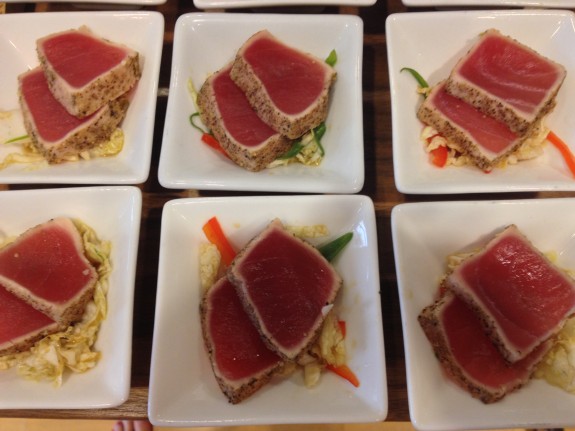
"Seared Ahi Tuna with Wasabi Vinaigrette" from Diet Simple: 195 Mental Tricks, Substitutions, Habits & Inspirations
my “Cool Cucumber Soup with Yogurt & Cilantro” from Diet Simple Farm to Table Recipes: 50 New Reasons to Cook in Season”…
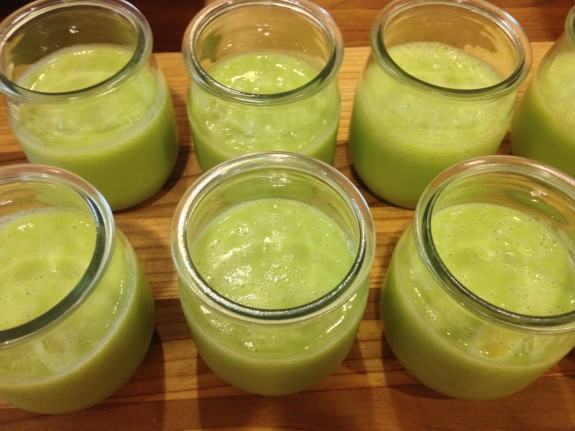
"Cool Cucumber Soup with Yogurt & Cilantro" from Diet Simple Farm to Table Recipes: 50 New Reasons to Cook in Season
and my “Melon Chunks with Crumbled Feta and Fresh Mint” (see recipe below) from Diet Simple Farm to Table Recipes: 50 New Reasons to Cook In Season”
A great time was had by all and everyone chose a plan of action to incorporate a new healthy habit into their lives. Now that’s transforming lives!
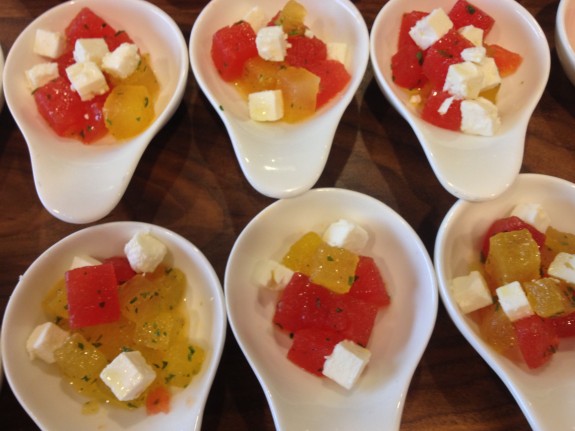
"Melon Chunks with Feta and Mint" from Diet Simple Farm to Table Recipes: 50 New Reasons to Cook in Season
Melon Chunks with Crumbled Feta and Fresh Mint
This is an unusual combination of flavors and textures, and a delight on the palate. Use any kind of melon that happens to be in season.
Serves 8
2 pounds melon chunks (about 1 small cantaloupe or seedless watermelon)
½ pound Feta Cheese or other similar cheese
8 small mint leaves, Chiffonade (Basil will also work)
Combine ingredients in a large bowl and serve!
Farmers Market Recipe: Fresh Kale & Summer Peach Salad with Toasted Almonds & Balsamic Vinaigrette
- At July 19, 2013
- By Katherine
- In News, Recipes
 0
0
“I don’t normally like kale, but this salad is delicious!” is a comment I hear over and over when I serve this dish. Last year around this time, I was volunteering at an Anacostia Farmers Market. At the time, there was only one produce farmer at the market and all he had the day I was coming was peaches, kale and potatoes! My job at the Farmers Markets is to inspire people to buy the locally grown produce available that day, but what the heck was I going to do with kale, peaches and potatoes? I was stumped! Then I leafed through my own book, Diet Simple: 195 Mental Tricks, Substitutions, Habits & Inspirations, and got inspired by one of Chef Carla Hall’s contributions to my book, her “Hearty Greens Salad with Warm Balsamic Cherry Vinaigrette.” Aha! I can do a variation on the theme, I thought, use peaches, add some crunch with toasted almonds and VOILA! It was a HUGE HIT at the Anacostia Farmers Market. So I’ve included this wonderful recipe in my new book: Diet Simple Farm to Table Recipes (Bookbaby 2013)
Today is the 5th “Katherine’s Market Recipe” of 2013, all of which are designed to be delicious, easy, quick, famiy-friendly, nutritious (heart-healthy & diabetes-friendly), and to highlight produce found at our local farmers markets this week. At your farmers market, you’ll find produce picked at peak ripeness, which means maximum flavor, texture, and nutrition. You’re also helping save the environment when you buy at your farmers market. Here’s how…
Serves 6
Vinaigrette:
3 Tablespoons Extra Virgin Olive Oil
1 Tablespoon Balsamic Vinegar
Salt and Pepper to taste
Salad Ingredients:
6 Handfuls of fresh Kale (or other greens), washed, tough stems removed, and torn into bite-sized pieces
2 Cups Fresh Sliced Summer Peaches and/or any seasonal Berries
2 Ounces toasted slivered Almonds
½ Sweet Onion, peeled and sliced
In a large bowl, add the olive oil, vinegar, salt and pepper. Whisk together. Add the kale, onion, almonds, and peaches and toss together. Serve immediately.

